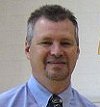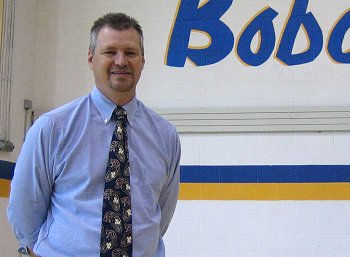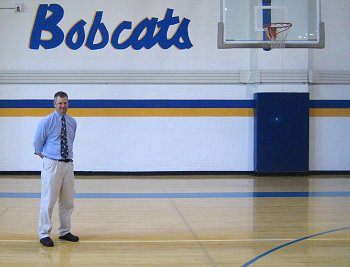- By Dan Veaner
- Sports
 Print
Print  John Taylor started at Lansing High School as Assistant Principal, Director of Physical Education, and Athletic Director on September 2. He sat down with the Lansing Star the next Friday to talk about the position, his past, and expectations for the future.
John Taylor started at Lansing High School as Assistant Principal, Director of Physical Education, and Athletic Director on September 2. He sat down with the Lansing Star the next Friday to talk about the position, his past, and expectations for the future. Taylor is soft spoken, engaged, and has a sense of humor. He lives in Binghamton with his wife Elaine. He has two step daughters. Megan, 21, goes to The College of Saint Rose in Albany. Laura, 18, is a senior at Chenango Valley High School.
In this week's issue Taylor talks about his background and training. Next week he talks about Lansing, the future, and a bit about his philosophy of sports and learning, and expectations for the future.
Lansing Star: Is everything as expected in your first four days?
John Taylor: It's everything I expected. I came from a school in the Adirondaks. I guess that was great training, because everything that has happened so far is the same.
LS: That was in Saranac, right?
JT: Correct.

LS: Your job there was almost identical, wasn't it?
JT: I was Dean of Students at the Middle School . They are very similar roles. It deals with discipline, the same duties.
LS: What attracted you to Lansing?
JT: I grew up in Owego. I've been in the area my entire life. I used to hang out in Ithaca. I like being in the Binghamton area. Lansing has a great history of sports and athletics. I saw that opportunity and jumped right on it as soon as I saw it. I'm grateful to Ed for leaving, and I thanked him yesterday when I spoke with him.
LS: Did you know Lansing's reputation? You were teaching in a different division?
JT: The league was STAC (Southern Tier Athletic Conference), and this is the IAC (Interscholastic Athletic Conference). But when we would go to Section 4 competitions I was very aware of Lansing.
LS: Let's go back. You went to high school in Owego?
JT: I graduated from Owego. I ran cross country and track there. I was height-impaired in high school. I was voted the shortest kid in my class in ninth grade. I wasn't even five feet tall. I loved to play basketball, but when everybody else is six foot four five feet doesn't make it. (laughs)
Then I went to Broome Community College. I was there for two years. I ran cross country there. They don't have a track team. I was not a stellar student. I didn't know what I wanted to do in life. I went to another two year school, Canton Ag & Tech. I was there for one year as a business management major. I graduated, but in the back of my mind everything I did was physical education. When I was in high school and even at Broome I wanted to be in physical education, but in the early '80s everybody said, 'You're never going to get a job. Don't do it. Go into business.'
I had some friends from Canton who were transferring to Brockport. I worked for a little while and decided business isn't for me. I transferred to Brockport State in physical education and took to it like a duck to water. Everything made sense. I was happy. I went for physical education and sports management and ran cross country as well.
From there I did my masters work at Elmira College, and did my administrative work at Cortland State.
LS: You've done a lot of coaching. Did that prepare you for coaching as well?
JT: Yes, my physical education classes did. I coached at Brockport State for one year as assistant coach in cross country.
LS: At that point did you want to become a physical education teacher and coach?
JT: Yes. I worked at Picciano Boys Club in Endicott for a while. I didn't have my teaching certification at the time, so I went back to Elmira College for my masters work and acquired my teacher's certification. And I started teaching physical education and coaching. I coached three sports during my entire teaching career. It was rough but I loved every minute of it.
LS: That was cross country, basketball, and track?
JT: Right.
LS: Was your first teaching job at the Catholic Schools of Broome County?
JT: Yes.
LS: How long were you there?
JT: 15 years.
LS: This was pre-K through 12, right? What were you doing there?
JT: I taught pre-K through 4th grade for a number of years. Then as the system seemed to dwindle they started cutting buildings. I was moved up to the middle school for a while, teaching 5 through 8. Then the system was cut even more and I was put up in the high school.
LS: That's got to be different teaching those different age groups, because they develop so much in 12 years.
JT: Yes and no, because the ones I had as five-year-olds later became my seniors. So I knew the majority of them when they got to high school.
LS: That had to be great for them.
JT: (laughs) Probably some, yes.
LS: You also served on the Goals 2000 Educate America Committee.
JT: Goals 2000 was New York State physical educators. We were trying to develop learning standards for physical education. Three standards came out of that, and everything is based on that now. They dealt with lifetime fitness, lifetime sports...
LS: Is that when that changed? When I took PE in school I don't remember anybody saying anything about lifetime fitness. It was more like, 'If I skip gym can I still pass?'
JT: Calling it 'gym' - now physical education' are the words we use because you're being physically educated. When you hear 'gym' you think of the team sports. It's not that any more. This Lansing area is a prime example. I come to work and I see five or six people running at 6:30- in the morneing as I come through Ithaca. I see people biking back and forth. And the lake itself is so involved with fitness and athletics. Being out on a boat, hiking... those are things that you can do for a lifetime. You've got Greek Peak right across the road for skiing. You've got golf courses here. There is more to it than just team sports.
LS: What did you do after you left the Catholic Schools?
JT: I did a one year paid internship in Camden. I was Dean of Students in the morning and in the afternoon I was the Vice Principal at an elementary school. I was very fortunate to get a full time paid internship. Most people do their administrative work right at their school. Being at a parochial school I wasn't going to get the knowledge that I needed to work in a public school, and my goal was to be in a public school.
I was away from my wife and the kids for a year. Camden is just north of Sylvan Beach on Oneida Lake.. My secretary at the time told me that the year before a snow storm dumped 45 inches of snow on her house in one night. She came down the hill the next day and they only had 20 inches there. (laughs)
LS: So that prepared you for working in a public school system?
JT: Yes. After I completed my internship and graduated from Cortland State with my Certificate of Advanced Study I was prepared to be an administrator in public schools in a school district.
LS: Is that what you did? Did you get an administration job right away?
JT: Yes, I got the position in Saranac. I interviewed there before I finished my internship in June of 2005. I started there in July as Athletic Director and Dean of Students. I was there for two years.
LS: Were you Director of Physical Education there as well?
JT: Yes.

LS: Is that a new thing? I know it's state mandated, but how new is that?
JT: There is going to be a state audit put out on physical education. They are looking at whether we are meeting the requirements and the needs of students. I would say the majority of schools in New York State are not meeting the mandates the state is putting out. They require 120 minutes of physical education per week. K through 4 is daily physical education by a certified physical education teacher.
Across New York State there is usually maybe one physical education teacher. You can't meet them all. They used to say that intermurals and after lunch recreation time, recess, counted. But it's not a structured activity that a physical education is teaching so it doesn't count. It's free time. It's play. It's different than physical education.
Part of it is making sure that you have a certified physical education director. To be that you have to be certified as a physical education teacher or health teacher. With your certificate of advanced study you can be Athletic Director, but you cannot be Director of Physical Education.
LS: Did you do that on purpose? Steve Grimm told me that half the applicants for your job didn't qualify because they weren't certified. When you got that certification did you have in mind that it would make you more marketable?
JT: No. I knew as a physical education teacher that I could be Director of Physical Education. But I also knew that if that wasn't something I really wanted to do I could be a vice principal or principal. I could be a superintendent if I was ever crazy enough! (laughs)
There are two different certifications now. There is school building leader, and school district leader. I was able to get through the program before they split them, so I can be all of them. Do I want to do that? (laughs)
----
v4i35




